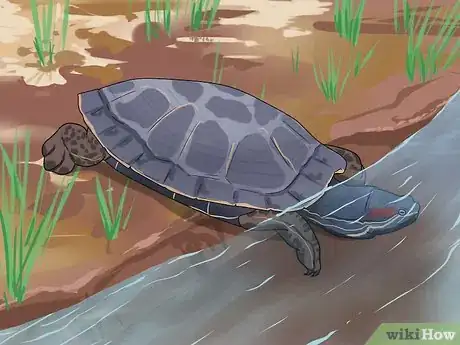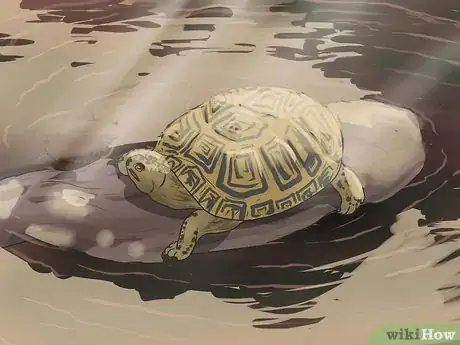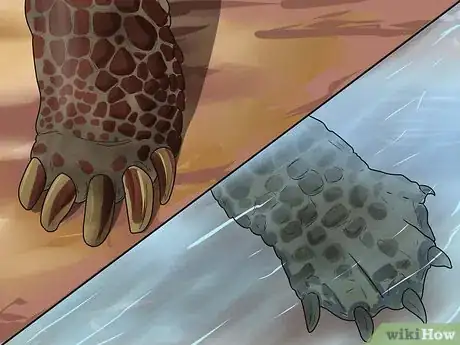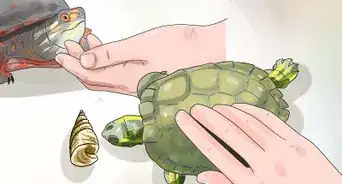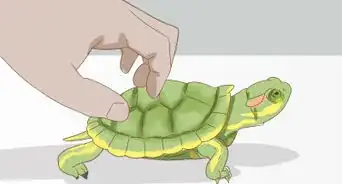This article was co-authored by Pippa Elliott, MRCVS. Dr. Elliott, BVMS, MRCVS is a veterinarian with over 30 years of experience in veterinary surgery and companion animal practice. She graduated from the University of Glasgow in 1987 with a degree in veterinary medicine and surgery. She has worked at the same animal clinic in her hometown for over 20 years.
wikiHow marks an article as reader-approved once it receives enough positive feedback. In this case, 86% of readers who voted found the article helpful, earning it our reader-approved status.
This article has been viewed 213,342 times.
Turtles, tortoises and terrapins are closely related reptiles of the order Testudines. These terms are often confused because of regional differences in English, and because the individual species look similar. Scientific taxonomy uses precise terminology to distinguish different species, but they can also be commonly classified on the basis of habitat, body type, and behavior: turtles dwell both in water (either saltwater or freshwater, depending on the species) and on land, terrapins dwell both in freshwater and on land, and tortoises are land-dwellers.
Steps
Examining the Environment
-
1Watch for time spent in water. Turtles spend most of their lives in water. Depending on its species, a turtle may inhabit fresh water (ponds and lakes) or the sea.[1]
-
2Determine if the reptile spends its time on land. Tortoises are land dwellers. Some tortoises live far from major sources of water, such as in deserts.Advertisement
-
3Observe if the reptile inhabits marshy regions. Terrapins spend time both on land and in water. However, they inhabit brackish waters such as marshes. Often the term “terrapin” is only used to refer to certain species living in marshes of the Eastern and Southern United States, such as the Diamondback Terrapin, or the Red-eared Terrapin (also called the Red-eared slider; this is a common pond and pet turtle).[2] [3]
-
4Pay attention to where and how the reptile basks. Turtles and terrapins will leave the water to bask in the sun on logs, sand, rocks, and other surfaces.[4] Sea turtles typically spend more time in water, but will leave to bask in the sun on beaches, reefs, and similar areas.
Checking the Body Type
-
1Examine the feet. Turtles and terrapins tend to have flattened, webbed feet for swimming.[5] Sea turtles are especially adapted for life in the water, with streamlined bodies and long, flipper-like feet.[6] Tortoises, however, have blunt, stumpy feet for walking on land. Their rear legs are elephantine, while their front legs are shovel-like for digging.
-
2
-
3Look for any distinguishing marks. If you suspect that you are observing a particular species of turtle, terrapin, or tortoise, look for markings on its shell or body that can help you determine this. For instance:
- The Diamondback Terrapin may be identified by the diamond-shape pattern on its shell.
- The Red-eared Terrapin may be identified by the distinctive red stripe on each side of its head.
- The Alligator Snapping Turtle may be identified by the pointed, peaked ridges on its shell.
Observing the Reptile’s Behavior
-
1Watch for periods of reduced activity. Turtles will burrow into mud during cold seasons and go into a state called torpor (similar to hibernation).[9] During this time, the turtles’ activity is minimal. They will remain in this state until warmer weather returns.
- Limited evidence shows that terrapins may also spend some time hibernating in mud, or in periods of reduced activity.
-
2Observe what the reptile eats. Eating habits of turtles will vary greatly by species and environment, but can include plants, insects, and other small animals. Since they are land dwellers, tortoises tend to eat low-lying plants such as grasses, shrubs, and even cacti.[10] The diet of terrapins has not been thoroughly studied.
-
3Determine nesting behavior. Land-dwelling tortoises will build nesting burrows and lay eggs. Species of turtles and terrapins that spend time both on land and in water, as well as sea-dwelling turtles, will all leave the water to lay their eggs.
References
- ↑ www.acsu.buffalo.edu/.../TURTLES%20AND%20TORTOISES.ppt
- ↑ www.acsu.buffalo.edu/.../TURTLES%20AND%20TORTOISES.ppt
- ↑ www.acsu.buffalo.edu/.../TURTLES%20AND%20TORTOISES.ppt
- ↑ www.acsu.buffalo.edu/.../TURTLES%20AND%20TORTOISES.ppt
- ↑ http://www.aqua.org/explore/animals/diamondback-terrapin
- ↑ www.acsu.buffalo.edu/.../TURTLES%20AND%20TORTOISES.ppt
- ↑ www.acsu.buffalo.edu/.../TURTLES%20AND%20TORTOISES.ppt
- ↑ www.acsu.buffalo.edu/.../TURTLES%20AND%20TORTOISES.ppt
- ↑ www.acsu.buffalo.edu/.../TURTLES%20AND%20TORTOISES.ppt
About This Article
To tell the difference between a tortoise, terrapin, and turtle, note the environment where the reptile spends most of its time, since turtles mostly live in the sea. On the other hand, you'll know it's a tortoise if it lives on land. If the reptile lives in marshes, assume it's likely a terrapin. You can also tell the difference by looking at their feet, as turtles and terrapins have flat, webbed feet for swimming, while tortoise feet are stumpy for walking. For tips on how to tell the difference between a turtle, terrapin, and tortoise based on their behavior, keep reading!


